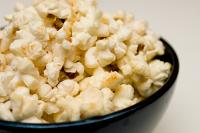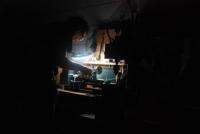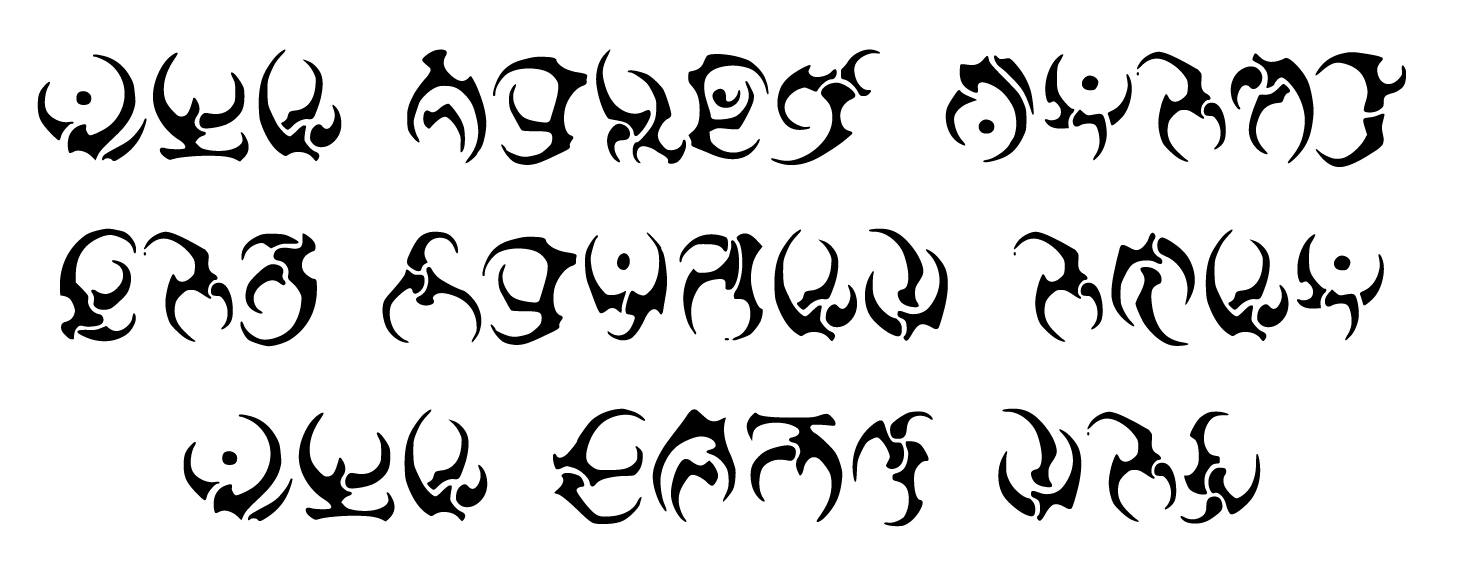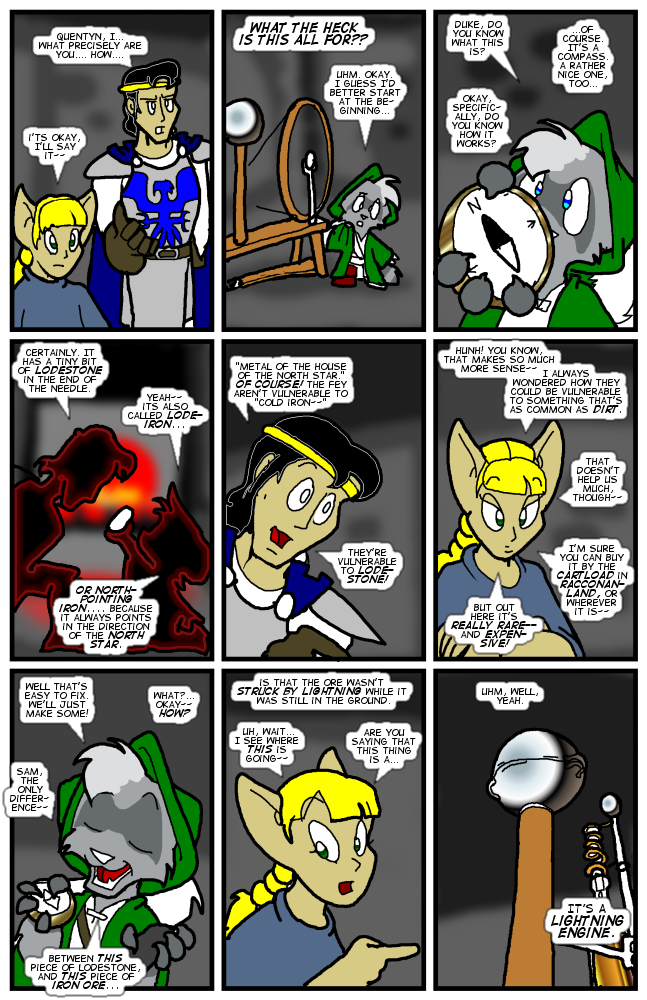Posting rules: Any registered member can create or post to a thread.
Question Cold Iron
- Nuuan
-
 Topic Author
Topic Author
Being an amateur knife maker I have some knowledge of metals and have always been confused at the term, "Cold Iron" and I have found several definitions online for the term, although most of them pertain to fantasy role playing games (D&D and the like) Which is fine as the Whateleyverse is fiction after all, but I am perplexed as to what the Whateley definition is for "Cold Iron"?
Since most steels are 95 -98% iron, what process of refinement removes the allergic reaction that fey creatures have to iron?
Does the heat of the forge remove the magical properties? If this is the case that would mean that any iron item that would effect a fey would have to be cold forged. In other words hammered out into shape without heating the metal. This would mean that any "Cold Iron" weapon or item would normally be very crude in appearance and small since it takes the heat of a forge to weld together the iron ore into a larger component. This style of "forging" would also leave the finished item very soft and unable to hold an edge.
Or is the Cold Iron found in the Whateleyverse actually meteoric iron? And is it the properties of this special type of iron that makes it deadly to the fey? If this is the case then some steel items would fit into the category of "cold Iron" Including most of the more expensive Japanese swords as many of the really high end ones are made from meteoric iron.
Or does it have to do with the carbon content ? Mild steel, steel with the lowest carbon content ranges from 0.005 - 0.025% of carbon. So is it simply a matter of steel or iron having a low carbon content? Wrought Iron, which has been written to have burned characters in some of the stories normally has a carbon content of 0.008 or less. Cast Iron on the other hand has a much higher carbon content than mild steel at 2 - 4% which would mean that it would not effect a fey.
- Malady
-

- elrodw
-

Never give up, Never surrender! Captain Peter Quincy Taggert
- Astrodragon
-

Basically there is no such thing as 'cold iron', just poor quality steel.
You wont find iron outside of a laboratory.
I love watching their innocent little faces smiling happily as they trip gaily down the garden path, before finding the pit with the rusty spikes.
- Sir Lee
-

Regarding steel's effects on Sidhe... it pretty much depends on the plot. You may work your own definition for your story. For magical purposes, you might, for instance, postulate that having about 1.1% carbon alloyed to iron partially "neutralizes" its Sidhe-poisoning ability; the neutralization effect lessens with more or less carbon. Having significant amounts of other metals alloyed also has a neutralizing effect (for instance, stainless steel has more than 10% chromium). How large this neutralizing effect is essentially plot-dependent.
That also goes for the Sidhe's allergic reaction to synthetic fabrics and dyes: it pretty much depends on how you define "synthetic." Some things are clearly natural, some are clearly synthetic, and some... fall somewhere in between. For instance, jeans shouldn't be a problem in theory, because it's essentially cotton dyed with a vegetable dye. But the problem is, some jeans fabric (particularly stretch jeans) are synthetic blends, and most indigo dye nowadays is synthetic. So some brands might be fine, while other brands make Fey literally break in hives.
- Nuuan
-
 Topic Author
Topic Author
And yes I agree with Elrod to an extent on whatever the plot requires, but this in its self can lead to inconsistencies and was hoping for a bit more definition as to what could be the definition in the whateleyverse
- Nuuan
-
 Topic Author
Topic Author
Sir Lee wrote: There actually was a long thread in the old forums about that. The general consensus is that there isn't a clear definition; it's generally understood to mean "old-fashioned iron stuff", which breaks down into two large categories: cast iron (2%-4.1% carbon) and wrought iron (less than 0.08% carbon). Cast iron didn't change much, but most stuff that's supposed to be "wrought iron" nowadays is actually mild steel (less than 0.25% carbon) -- but you may assume that mild steel will work as "cold iron" too.
Regarding steel's effects on Sidhe... it pretty much depends on the plot. You may work your own definition for your story. For magical purposes, you might, for instance, postulate that having about 1.1% carbon alloyed to iron partially "neutralizes" its Sidhe-poisoning ability; the neutralization effect lessens with more or less carbon. Having significant amounts of other metals alloyed also has a neutralizing effect (for instance, stainless steel has more than 10% chromium). How large this neutralizing effect is essentially plot-dependent.
That also goes for the Sidhe's allergic reaction to synthetic fabrics and dyes: it pretty much depends on how you define "synthetic." Some things are clearly natural, some are clearly synthetic, and some... fall somewhere in between. For instance, jeans shouldn't be a problem in theory, because it's essentially cotton dyed with a vegetable dye. But the problem is, some jeans fabric (particularly stretch jeans) are synthetic blends, and most indigo dye nowadays is synthetic. So some brands might be fine, while other brands make Fey literally break in hives.
Thanks Sir Lee, I should have known if anyone remembered a thread on this it would be you
I liked the idea of the poisonous effect having to do with the amount of carbon/purity of the iron. But cast iron having high amounts of carbon and other impurities and still remaining poisonous to fey would mean this line of though is incorrect.
I did not know of the "Old style Iron" which we can assume would be hand forging using wood/coal fire and anvil and hammer as the tools to work the metal. Making modern kitchen knives. swords and tools such as pliers and wrenches safe to a fey as these are most often drop forged.
Even most knife makers no longer use a wood/coal fire forge and instead use propane or natural gas, which is not "Old style" and thus the items created from such would not be poisious to the fey
- elrodw
-

For iron, it's backwards - the less 'foreign' content (e.g. carbon, chromium, other alloying metals), the less tolerance, with an exponential relationship.
I like the idea of that type of interference with magic. We need to discuss this in our weekly cabal business, random-idea-tossing, convoluted-plot-developing, character-torturing, and scotch-drinking tagup
Never give up, Never surrender! Captain Peter Quincy Taggert
- E. E. Nalley
-

I would rather be exposed to the inconveniences attending too much liberty than to those attending too small a degree of it.
Thomas Jefferson, to Archibald Stuart, 1791
- lighttech
-

A naturally formed iron found in nature, formed into a blade or weapon. (cold iron)
But the more you messed with it...forged it, heated it, pounded on it.
The less natural it became and thus "lost" that part that made it dangerous to Sidhe!
So in this way, Fey can ride in man made cars and use a fork at school with no issues --but find a blade made that OLD way? And we have issues!
Part of the WA Drow clan/ collective
Author of Vantier and Shadowsblade on Bigcloset
- Malady
-

E. E. Nalley wrote: Start reading here
www.rhjunior.com/tales-of-the-questor-0475/
Oh! Like Pratchett! *facepalm* That makes so much sense!
... Lodestone , the character, seems important now... We don't have a Wiki Page for her at the moment, she only appeared in A Glow In the Darkness . ... She is another of those returned FFC beings like Aung and Kodiak? And Lodestone is an old, old name? She is scourge of the Sidhe?? ... IIRC, her powers must be from her specific Sidhe nature, if she's a sidhe, 'cause they don't get human mutations... *freakout*
And in regards to synthetics, perhaps their irritation its something about Essence? How well can synthetics channel Essence or something?
- Nuuan
-
 Topic Author
Topic Author
elrodw wrote: I'm using an exponentially-increasing reaction based on synthetic content for fabrics and dyes for Elle. Example - let's say that Elle can tolerate up to 5% synthetic for eight hours. Let's call that threshhold 1 unit. So if she has 2 units (10%) her tolerance might be 2 hours (square law) or 1 hour (cube law). 15% = three units -> 1hour, 17 minutes (square) or 17 minutes (cube). 20% -> 1/2 hour (square) or 7.5 minutes (cube). 100% = 20 units = just over 1 minute (square law) or 3.6 seconds (cube). You get the picture - more synthetic material = very rapidly less tolerance time. I haven't talked with the others about how this would work conceptually or what the relationship would be, but as a general principle, it's a sound idea.
For iron, it's backwards - the less 'foreign' content (e.g. carbon, chromium, other alloying metals), the less tolerance, with an exponential relationship.
I like the idea of that type of interference with magic. We need to discuss this in our weekly cabal business, random-idea-tossing, convoluted-plot-developing, character-torturing, and scotch-drinking tagup
Yes that is pretty much the idea I was following but if in fact cast iron has the same poisonous properties as other forms of iron/mild steel due to the low amounts carbon or other material. With the more pure the iron the more poisonous, that would make cast iron safe to the fey since it is possibly the least pure of any form of iron or steel.
Thus the conundrum, if it has to due to the purity or percentage of impurities in the iron, Cast iron would not be poisonous. That is why I immediately began leaning over to what Sir Lee posted about "Old style iron".
Defining the Whateleyverse's "Cold Iron" as iron or steel that has been worked or forged using old style methods and tools that were available during the early iron age would make it possible to still have a "Cold Iron" product made today, but highly unlikely and somewhat rare due to the means of creation.
So a Katana bought on ebay for 59.99 would be safe to fey, as it would most probably be drop forged. But a Japanese Katana created by a master swords smith using 300 year old techniques in a 200 year old coal forge, would be poisonous to fey creatures.
Even most knife makers today do not use coal fired forges, they take forever to get up to temperature and the control over the temperature is not as precise, thus the wide use of propane and natural gas forges.
- Nuuan
-
 Topic Author
Topic Author
Malady wrote:
E. E. Nalley wrote: Start reading here
www.rhjunior.com/tales-of-the-questor-0475/
Oh! Like Pratchett! *facepalm* That makes so much sense!
... Lodestone , the character, seems important now... We don't have a Wiki Page for her at the moment, she only appeared in A Glow In the Darkness . ... She is another of those returned FFC beings like Aung and Kodiak? And Lodestone is an old, old name? She is scourge of the Sidhe?? ... IIRC, her powers must be from her specific Sidhe nature, if she's a sidhe, 'cause they don't get human mutations... *freakout*
And in regards to synthetics, perhaps their irritation its something about Essence? How well can synthetics channel Essence or something?
While the idea has some merit, magnetism being the cause of the metal becoming poisonous? That would make it way to easy to make tons of items that would be poisonous to the sidhe, and who knows what would happen if someone turned on a giant electromagnetic near a group of sidhe?
- lighttech
-

is the rarer the better===meteorite or volcanicly formed iron, made into a blade
with 'maybe' some 'maybe'? Magical forging?
Part of the WA Drow clan/ collective
Author of Vantier and Shadowsblade on Bigcloset
- Malady
-

Nuuan wrote:
Malady wrote:
E. E. Nalley wrote: Start reading here
www.rhjunior.com/tales-of-the-questor-0475/
... Lodestone , the character, seems important now... We don't have a Wiki Page for her at the moment, she only appeared in A Glow In the Darkness . ... She is another of those returned FFC beings like Aung and Kodiak? And Lodestone is an old, old name? She is scourge of the Sidhe?? ... IIRC, her powers must be from her specific Sidhe nature, if she's a sidhe, 'cause they don't get human mutations... *freakout*
While the idea has some merit, magnetism being the cause of the metal becoming poisonous? That would make it way to easy to make tons of items that would be poisonous to the sidhe, and who knows what would happen if someone turned on a giant electromagnetic near a group of sidhe?
Well, yeah, magnetism as a weakness doesn't make any sense for Whateley-verse Sidhe, but Lodestone's the only Sidhe (If that's what she is) we know that can control iron (Well, by something like TK. Or was it actually said to be magnetism?). No other non-Mythos mage we know can do that? ... Unless Hekate's Iron Golem Spell is non-Mythos. ... But she did need sacrifices for it.
- Nuuan
-
 Topic Author
Topic Author
lighttech wrote: my vote for a conclusion on this?
is the rarer the better===meteorite or volcanicly formed iron, made into a blade
with 'maybe' some 'maybe'? Magical forging?
Forged in a magical fire has possibilities. What was that 70's movie dragons slayer or something close to that name? where the weapons the boy was given was heated with magic instead of a forge prior to the blacksmith hammering it to a harder, sharper weapon?
Although in the whateleyverse I would think magically fired forging would be more abundant than 300 year old weapons smithing techniques as anyone who has swung a 3 lb hammer for more than 5 minutes can attest, it ain't as easy as it looks.
- Sir Lee
-

I must clarify a bit: what I meant when I wrote "old-fashioned" iron was not about making it by old processes -- rather, that in common parlance "iron" tends to be used for things of an old-fashioned design, sorta bulky and heavy, made from thick bars or cast into thick pieces. Even if they actually use mild steel made in a modern mill, and processed by modern machinery...
There are several possible ways to define "cold iron" for a magical fictional universe if you think of it ahead of time.
One simple way to do it is to include steel, which is not a problem if refined iron in any form is fairly uncommon/expensive in your setting -- most medieval settings and older can work that way.
Another is to restrict it to magnetic iron, as in the linked webcomic. That makes it rarer, and extends the rarity pretty much beyond First Industrial Revolution, becoming common only when electricity offers an efficient way to magnetize large amounts of iron.
Or to meteoric iron, as some stories do. That will make it very, very rare until advanced space travel.
But the truth is that this does not seem to have been planned ahead of time in the case of Whateley. So the definition is a bit ad-hoc. It's annoying in a way, but it also gives a lot of wiggle room to the writer. Maybe some Sidhe are more sensitive than others. Maybe some forms of iron are more harmful than others.
- Valentine
-

Sir Lee wrote: The real problem, in the Whateley-verse, is that we have seen Fey avoiding things like wrought iron benches, and Ayla has used pieces of an ordinary wrought iron railing to hurt a major demon. And both are quite likely to be mild steel and not actual wrought iron, unless they happen to be real antiques.
I must clarify a bit: what I meant when I wrote "old-fashioned" iron was not about making it by old processes -- rather, that in common parlance "iron" tends to be used for things of an old-fashioned design, sorta bulky and heavy, made from thick bars or cast into thick pieces. Even if they actually use mild steel made in a modern mill, and processed by modern machinery...
There are several possible ways to define "cold iron" for a magical fictional universe if you think of it ahead of time.
One simple way to do it is to include steel, which is not a problem if refined iron in any form is fairly uncommon/expensive in your setting -- most medieval settings and older can work that way.
Another is to restrict it to magnetic iron, as in the linked webcomic. That makes it rarer, and extends the rarity pretty much beyond First Industrial Revolution, becoming common only when electricity offers an efficient way to magnetize large amounts of iron.
Or to meteoric iron, as some stories do. That will make it very, very rare until advanced space travel.
But the truth is that this does not seem to have been planned ahead of time in the case of Whateley. So the definition is a bit ad-hoc. It's annoying in a way, but it also gives a lot of wiggle room to the writer. Maybe some Sidhe are more sensitive than others. Maybe some forms of iron are more harmful than others.
Given where Fey was avoiding the wrought iron, and Phase gathering the wrought iron railings, it is possible that they were, if not antiques, old enough to be actual wrought iron.
Don't Drick and Drive.
- Nuuan
-
 Topic Author
Topic Author
I guess in the case of iron and steel we need to describe the stages of which iron ore becomes steel.
Iron ore -- this is the crude stuff that is dug up out of the ground.
Pig Iron -- This is created when iron or is placed in a smelter and combined into large blocks of crude iron
Cast iron -- Pig iron or iron ore is smelted and poured into a mold and allowed to cool
Wrought Iron -- Pig Iron is melted in a puddling furnace further refining it.
Steel -- Wrought Iron that has carbon and possibly other alloys added to to to create a stronger harder material
Wrought Iron is any steel that has less than 0.1% carbon content. It is very malleable and can with difficulty be bend or shaped without heating.
Not trying to be difficult, just working on getting a handle on what is what
- Kettlekorn
-

And then there's the fact that magic tends to be less based on anything sensible and more based on whatever ruts people have worn into the fabric of reality through their traditions, resulting in all sorts of silly bullshit.
Personally though, I liked Sir Lee's sweet-spot hypothesis where a particular range of carbon content makes the iron safe, but having too much or not enough leaves it unsafe. It might be that there's something mystically significant about the specific ratios of carbon to iron used in steel, or maybe the Sidhe did some sort of ritual that created that particular immunity -- or alternately, created the weakness to other ratios as a side-effect/cost of whatever greater goal the working was meant to achieve. It could also be something that was done to the Sidhe, not by the Sidhe. Several times we've heard of some big mystical agreement set up by Solomon or something; perhaps a part of that was that magical creatures would have a weakness to "cold iron" when operating in the vicinity of Earth. If so, cold iron might have been defined in such a way that excludes steel (possibly by accident). Or, tying back to what I was saying earlier, it might be a matter of what the individual believes to constitute cold iron.
- Malady
-

- Astrodragon
-

One theory thats been used a few times is that its the magnetic field which is actually causing the problems with magic - and iron/steel was the only common material to show this property til (relatively) recent times.
I love watching their innocent little faces smiling happily as they trip gaily down the garden path, before finding the pit with the rusty spikes.
- Sir Lee
-

But magnetic effects don't fit the Whateley setting. For one thing, Fey would get sick near power lines... and refrigerator magnets would be Sidhe-killing bullets.
I really like the "Contract of Solomon" idea, though. It's canon that it exists and places constraints on magical beings, so it could explain a lot. Maybe the reason that steel is not as damaging as iron is that it's a form of iron that didn't EXIST back when the Contract was written... so the relevant magic treats it as a "kinda-sorta" iron, with milder effects than "traditional" iron.
Why would that even make sense? Well, it doesn't from a chemical POV, but it might from a magical POV. Consider carbon allotropes, for instance. Would any wizard think graphite is a decent substitute for diamond? No, if your grimoire says that you need a diamond to store a curse, you don't go making a Cursed Lump of Coal.
As for iron in dirt... it's not in metallic (crystalline) form. It's iron oxide, mixed with a lot of other stuff, mostly silicon dioxide. You might say that, from a magical standpoint, it's too "impure" to have any significant magical effects...
...OTOH, earth has magical significance. Hmmm. Maybe the iron content in the earth plays a role in that.
- Nuuan
-
 Topic Author
Topic Author
Kettlekorn wrote: One possibility is that it's partially based on the expectations of the people involved. The second Champion had that psychological weakness to "Tartarium" after all. When it comes to innately magic critters like demons or Sidhe, placebo affects could have a much bigger impact on them than with humans. Especially if there's a hint of truth -- if the material is close enough to being cold iron to at least cause a small effect, that could give them enough seed to inflate the effect into something much bigger if they believe that it really is cold iron.
And then there's the fact that magic tends to be less based on anything sensible and more based on whatever ruts people have worn into the fabric of reality through their traditions, resulting in all sorts of silly bullshit.
Personally though, I liked Sir Lee's sweet-spot hypothesis where a particular range of carbon content makes the iron safe, but having too much or not enough leaves it unsafe. It might be that there's something mystically significant about the specific ratios of carbon to iron used in steel, or maybe the Sidhe did some sort of ritual that created that particular immunity -- or alternately, created the weakness to other ratios as a side-effect/cost of whatever greater goal the working was meant to achieve. It could also be something that was done to the Sidhe, not by the Sidhe. Several times we've heard of some big mystical agreement set up by Solomon or something; perhaps a part of that was that magical creatures would have a weakness to "cold iron" when operating in the vicinity of Earth. If so, cold iron might have been defined in such a way that excludes steel (possibly by accident). Or, tying back to what I was saying earlier, it might be a matter of what the individual believes to constitute cold iron.
I think that sweep spot idea, along with the placebo effect could easily be used to describe the effects we have seen up to date in canon and most of not all the fanfic and whatif stories.
Since wrought iron has almost no carbon content, it is at one end of the spectrum, and cast iron which has a very high carbon content is at the opposite end of the spectrum, it can be said that only the far ends of the spectrum of steel has this effect.
Even going as far as that magic was used to grant the sidhe immunity to the more broader range of carbon steel that is used to make tools and weapons so that the sidhe could also use steel tools and weapons. And that the magic was not all encompassing, leaving iron based metal with very low and very high carbon content still poisonous to the sidhe, Which would produce this sweet spot.
Then of course the placebo effect that was stated would account for the variances in the effect of poisoning a character encounters in a story.
This is great, I knew you guys could come up with a logical reason as to how and why this poison effect works
Of course the magical means of this sweet spot is just speculation, as far as teh whateleyverse goes it could be an unknown with several theories as to its origin
- rubberjohn
-

John.
- lighttech
-

rubberjohn wrote: Just to muddy the water of the subject a little more it occurred to me, while catching up on this thread, that Iron is what makes blood red. Could this be a part of what makes blood so powerful as an ingredient of some of the darker spells?
John.
what I have read in canon on this 'blood magic' is that any body part will do, hair, blood, nail clippings ect
its just like a DNA magic missile, the spell goes back to the origin of the part.
Part of the WA Drow clan/ collective
Author of Vantier and Shadowsblade on Bigcloset
- Astrodragon
-

Hence the cheerful blood sacrifices of cultists...loads of power immediately available.
I love watching their innocent little faces smiling happily as they trip gaily down the garden path, before finding the pit with the rusty spikes.
- Valentine
-

lighttech wrote:
rubberjohn wrote: Just to muddy the water of the subject a little more it occurred to me, while catching up on this thread, that Iron is what makes blood red. Could this be a part of what makes blood so powerful as an ingredient of some of the darker spells?
John.
what I have read in canon on this 'blood magic' is that any body part will do, hair, blood, nail clippings ect
its just like a DNA magic missile, the spell goes back to the origin of the part.
I think he is talking more about the use of blood and/or sacrifice to get power as opposed to using it as a link to the victim.
Don't Drick and Drive.
- Ametros
-

So like Elrod suggested, the more pure the iron, the greater the effect on Sidhe, and if I'm reading it right, the more synthetics in a product, the greater effect also.
Electronics must be a bitch to use. Smartphones less so, but still.
And to head off comments about iron in blood regarding Sidhe, I believe we nothing very little about the specifics of their physiology beyond them not being human? Fey's blood being vaporised due to the active old magic presents ambiguity as to whether Sidhe blood actually has iron in it as ours does.
Seriously, thank you for your time and effort. It is appreciated.
- Malady
-

- Sir Lee
-

Second... if memory serves well (I would have to reread the story to check), the Necromancer was NOT able to preserve Fey's blood; he did preserve part of her hair -- the part that had grown *before* the Blood Oath ritual and therefore no longer matched Fey's DNA or whatever Sidhe have in place of it. The newer parts (near the root of the hair) did vaporize.
- Kristin Darken
-

I've always personally read Sidhe 'allergies' as a result of materials that interact with/influence the flow of magick/essence. And yes, magnetic fields should be very disruptive to the flow of magick...
There are two 'known' "World Magick" wards still surviving in the contemporary world that survived the Sundering. They survived mainly by having as their 'target' living Sidhe. There were no living Sidhe anywhere in the world because of the loss of Essence... so the wards went dormant through the times when Essence was so weak that the wards would have collapsed under use. By the time Sidhe started to return, the natural flows of Essence had recovered enough to sustain a rarely used world class magick.
1. Defense against Harvesting - the components of a Sidhe cannot be harvested for use in ritual (blood, flesh, nails, hair), preventing bindings, subversion, and manipulation and identity theft through magickal means.
2. Defense of the Court Young - prior to assuming their majority, the Court youth are protected through charms of emotion and protectorship to minimize the ability of enemies to attack the young and for the young to be able to draw allies to defend them in the event of real troubles.
Fate guard you and grant you a Light to brighten your Way.
- JG
-

I personally define cold iron as low-heat hand-forged iron that has specific (not compatible with modern) processes to create the final product. Old wrought iron from the early days of the world would qualify, Iron manacles from the dark ages are a coin flip based on the techniques used to make them.
In my brain Magic is as much about symbolism and sacrifice as it is about power. One man mimicking another's path to refining a power metal would not have the personal attachment, belief and juice to do the work.
Mithril would be a ritualistic extraction from silver and likely mercury, highly reactive to the fae and magic
Orichalcum would be a refinement of gold, attuned to...??? also highly reactive to magic, and barbecues demons on contact.
Bloodsteel is reactive to magic in that it draws magic (and life energies) inward to itself so its wielder or the item its attached to can draw power. An ounce of Bloodsteel can be refined from a single human life taken.
Now imagine what it would have taken to create the artificer, for whom this stuff is the blood in her veins. And it, by itself, is inimical to life.
Adamant (not to be confused with Devisor Adamantite) is an alloy of Diamond and Obsidian. It's a smoky material that is partially translucent, black and as far as anyone can tell? Utterly indestructible. Once Adamant is shaped, it can never be reshaped, reforged or slagged. it's a fact, to borrow a quote from Dr. Who, a fixed point in time and space.
Cold Iron, in my brain is little different from any of the odd materials I've laid out here. The difference being, Cold Iron is the purview of mortal men and women. Humans without magic. Creatures who rely, or are made from, magic risk self-annihilation, or at the very least great losses of personal power were they to forge any such thing. Cold Iron is to magic what a lightning rod is to a thunderstorm. The ritual to make it is simply different, and those without magic can make it.
- Malady
-

JG wrote: Bloodsteel is reactive to magic in that it draws magic (and life energies) inward to itself so its wielder or the item its attached to can draw power. An ounce of Bloodsteel can be refined from a single human life taken.
Now imagine what it would have taken to create the artificer, for whom this stuff is the blood in her veins. And it, by itself, is inimical to life.
Okay, looked at my old questions on this stuff... What hasn't been answered. Ah. Physical Properties? Weight, electrical conductivity, sharpness, etc.
By itself, vampiric steel, ... However it's an accelerator for other shit when used SPARINGLY in conjunction with other materiels.
What does it accelerate and do you have to use it SPARINGLY?
JG wrote: Adamant (not to be confused with Devisor Adamantite) is an alloy of Diamond and Obsidian. It's a smoky material that is partially translucent, black and as far as anyone can tell? Utterly indestructible. Once Adamant is shaped, it can never be reshaped, reforged or slagged. it's a fact, to borrow a quote from Dr. Who, a fixed point in time and space.
Well, shit, it can't be reshaped. Whoever's making it better know that, else they're gonna possibly make some very expensive failures...
... Well, unable to be reshaped by known thingies... What about new mutant thingies, like how Silver's a living Moonsilver Fountain? Although, Silver might be possible without mutation, its just that noone ever thought to make someone like her?
So armor made out of it is only good for you, and others who are like you? ... Actually, is it even any good as armor, if it doesn't buckle with the force and may transmit a lot of it to the body its protecting?
- JG
-

I dunno if it will ever see the light of day.
As far as things go, cold iron conductivity would vary. It's the ritual of forging it that matters.
Electrical conductivity of the others is largely untested. They're too valuable to mages for anyone to be willing to hand over to a gadgeteer without bloodshed.
- Valentine
-

JG wrote:
Nope adamant would transfer all the force. As a shield, its useful. Not so much for breastplates. I actually have a scene written where an adamant forgefire if burning.
I dunno if it will ever see the light of day.
As far as things go, cold iron conductivity would vary. It's the ritual of forging it that matters.
Electrical conductivity of the others is largely untested. They're too valuable to mages for anyone to be willing to hand over to a gadgeteer without bloodshed.
Shouldn't it work well as a breastplate? If you were shot with a 45, the force would be spread over a couple of square feet, instead of just the bullet.
Don't Drick and Drive.
- null0trooper
-

JG wrote: Electrical conductivity of the others is largely untested. They're too valuable to mages for anyone to be willing to hand over to a gadgeteer without bloodshed.
No problem!
"This is an ounce of bloodsteel, provided for the purpose of testing its physical properties, here, at this facility. Rest assured that if a significant amount of it is lost or destroyed, we do have a source for replacement lined up already."
Forum-posted ideas are freely adoptable.
WhatIF Stories: Buy the Book
Discussion Thread
- JG
-

Valentine wrote:
Shouldn't it work well as a breastplate? If you were shot with a 45, the force would be spread over a couple of square feet, instead of just the bullet.
Because if you get hit with a large enough bullet, the force will transfer to your ribs directly and you'll get flail chest and/or massive compression trauma.
Besides which, the prohibitive cost and need to have a month (if you're an artificer) to years-long forging process, and going to bug a devisor for some hard-to-obtainium is just more cost-effective.
- Mister D
-

When he gets around to replying, i'll let folk know here.
Measure Twice
- Malady
-

Or Haematid's manifested blood?
- null0trooper
-

Malady wrote: Since this is apparently now the Magical Materials thread? What happens if you make bloodsteel out of non-human life, like animals?
First, you'd want a viable collection platform. Luckily, someone's already thought about Devisor mosquitoes , not that A. aegypti isn't bad enough.
Then, you'd only need to program a selection filter for appropriate sources.
For a chaos magician working from appropriate correspondences (Liber 777 as a reference, some other use of gematria, legends, etc.) it may be possible to use non-human sources, albeit at a sharp decrease in efficiency. Instead of slaughtering a mid-sized village, your minions instead annihilate all the livestock and game animals in a 100 km radius. Sure, the people living there may need to take up a vegan lifestyle for a while, but isn't that far more eco-friendly?
For Traditions not working from a Devisor model of Magick
If the actual procedure calls for one soul's worth of blood (like "juice from one lemon") to produce one ounce of bloodsteel, then economy-sized sentient or potentially sentient creatures like cetaceans, giants, some trolls, etc., could be safe from harvesting. Each one would be yielding way too much raw matter to alchemically process, compared to Stumpy the Village Idiot, or the alchemist's latest ex. If, like livestock, the remainder of the carcasses would not be going to waste, maybe it's feasible to render Shamu for a little bloodsteel and catfood. One may still need to look into the possibility of offsetting the "large volume" donors with a number of pixie- and brownie- sized donors.
Malady wrote: Or Haematid's manifested blood?
Ehm... A couple of scenarios come to mind:
a) It's just undifferentiated stuff o' creation (or SpamTM) that takes on all the physical characteristics of blood (human? squirrel? not horseshoe crab) as it's manifested into this universe. If "soul" or "essence" is required, it may not work. Perhaps that can be tested by swapping it for your friendly local vampire's midnight snack?
b) It's real, magically-potent blood alright. You know how in the Full-Metal Alchemist anime, "alchemy" is fueled by departed human souls passing through The Gate? As long as no one in the other world/plane starts wondering why Dear Aunt Tilly didn't come back for her next incarnation, we should be alright, right?
c) A bit of "all of the above". It's being siphoned out of a Space Whale (Dr. Who, "The Beast Below", Torchwood, "Meat") or some aspect/descendent of a GOO. Cook it up and see that happens!
tl,dr: No matter how the alchemist goes about it, that workshops going to be a Nightmare Fuel Station.
Forum-posted ideas are freely adoptable.
WhatIF Stories: Buy the Book
Discussion Thread
- Anne
-

Adopt my story: here
Nowhereville discussion
- Malady
-

- Anne
-

Adopt my story: here
Nowhereville discussion
- Kristin Darken
-

One person, alone in the universe with nothing else to influence the flow of Essence, can achieve anything... but will probably achieve nothing but removing herself from the equation. No limitations to what can be defined except those limitations within the mage... but at the same time, no safeties or inherent protection except those within the mage. Cause of 'removal from existence'? Stray thoughts.
But with other people around, we begin to establish limitations and barriers to how interaction can occur. We create paths. Some people follow paths, some create more paths. These become fundamental parts of how we define ourselves and our thoughts and will operate within that definition. A mage's influence over magick (and reality) is generally inhibited by the thoughts and will of others to a degree that most people cannot overcome. The larger the population, the more this is true. In fact, the concept of overcoming societal inertia (breaking paradigm or 'thinking outside the box') only becomes more difficult the more people there are and the greater their involvement in each other's lives.
Fate guard you and grant you a Light to brighten your Way.
- Malady
-

- null0trooper
-

Malady wrote: On Adamant... How is it against Destiny's Wave or Billie's Death Blow?
Destiny's Wave seems to be one of those blades that cuts "worthless objects" (e.g., Zantetsuken). If the Tao wills it to cut, it will cut.
Depending on how indestructible Adamant is (it almost sounds like it's a physical "fixed point in time and space"), one has to hope that the Death Blow will destroy an item made of it, lest the destruction simply eat a multidimensional hole in reality around it. The blow bouncing back, or away, from an adamant item might also cause Bad Things to Happen.
Forum-posted ideas are freely adoptable.
WhatIF Stories: Buy the Book
Discussion Thread
- mhalpern
-

Well we know that adamant can withstand Tennyo's energy swords, but it is possible that she can destroy it, with massive calatoral damagenull0trooper wrote:
Malady wrote: On Adamant... How is it against Destiny's Wave or Billie's Death Blow?
Destiny's Wave seems to be one of those blades that cuts "worthless objects" (e.g., Zantetsuken). If the Tao wills it to cut, it will cut.
Depending on how indestructible Adamant is (it almost sounds like it's a physical "fixed point in time and space"), one has to hope that the Death Blow will destroy an item made of it, lest the destruction simply eat a multidimensional hole in reality around it. The blow bouncing back, or away, from an adamant item might also cause Bad Things to Happen.
Any Bad Ideas I have and microscene OC character stories are freely adoptable.
- Sir Lee
-

First, let's look at Adamant x Destiny's Wave.
Adamant is hard to make, but it's still possible for human sorcerers. It's High Magic, but the Tao works in a whole 'nother level. The Tao works in Deep Magic. High Magic still has to follow the rules. Deep Magic is the rules.
To put it another way... Warren Ellis once (in his Planetary series) defined magic as "cheat codes for the world." The Tao does not work with cheat codes; it works with the root password to the world.
As for Tennyo's Death Blow? Well, Adamant is still part of this worldly reality. The Death Blow destroys locally that reality. Going back to the computer analogy, Adamant is still part of the software of the world; the Death Blow works at the hardware level. No software can block a hardware attack.
- Valentine
-

mhalpern wrote:
Well we know that adamant can withstand Tennyo's energy swords, but it is possible that she can destroy it, with massive calatoral damagenull0trooper wrote:
Malady wrote: On Adamant... How is it against Destiny's Wave or Billie's Death Blow?
Destiny's Wave seems to be one of those blades that cuts "worthless objects" (e.g., Zantetsuken). If the Tao wills it to cut, it will cut.
Depending on how indestructible Adamant is (it almost sounds like it's a physical "fixed point in time and space"), one has to hope that the Death Blow will destroy an item made of it, lest the destruction simply eat a multidimensional hole in reality around it. The blow bouncing back, or away, from an adamant item might also cause Bad Things to Happen.
Tennyo didn't use her energy sword in the match against Jericho, she just used her plasma balls and a few other tricks. But she does mention this:
The shield he was holding was odd. There was a thin layer I figured was some kind of enamel which burned through quick. But under that was what I could only describe as a very tight material. Most materials I encountered had definite spaces and cracks in them I could force my energy through and break up, burn, cut, whatever. This one didn’t have that. I wasn’t sure what level of energy I’d need to actually force it apart, but I was willing to bet it wouldn’t be good for the rest of the school and I wasn’t about to risk it. I’d have to ask him where he got it if I had a chance.
So she could destroy it, but is unsure what else would survive. I'm guessing this might be a close analogy of the situation with Tennyo's sword and Jericho's shield.
Don't Drick and Drive.
- Kettlekorn
-

- JG
-

This includes Tennyo and Destiny's Wave.
- Mister D
-

Sir Lee wrote: I would think that adamant wouldn't be able to resist to either one.
First, let's look at Adamant x Destiny's Wave.
Adamant is hard to make, but it's still possible for human sorcerers. It's High Magic, but the Tao works in a whole 'nother level. The Tao works in Deep Magic. High Magic still has to follow the rules. Deep Magic is the rules.
To put it another way... Warren Ellis once (in his Planetary series) defined magic as "cheat codes for the world." The Tao does not work with cheat codes; it works with the root password to the world.
Shouldn't that be the Root password to the multiverse?
Measure Twice
- Bek D Corbin
-

• Bronze is an alloy of Copper and Tin. Copper is found in ore form almost everywhere, but Tin ore is pretty dang rare. One of the reasons why civilization started in the Eastern Mediterranean was the placement of large deposits of Tin in the Black Sea
• Iron doesn’t need any alloy, and it’s found dang near everywhere
• Bronze can be smelted by any yahoo with a pot and a campfire. Skills and Tools needed are pretty minimal
• Iron on the other hand, needs a LOT of Skill and Work to be anything but crap. And it requires a specialized furnace to be smelted into a useable form
And then someone found out how to make STEEL, and it was a whole new game!
PS, and Yes, I found a Metallurgy site to check this up. I may not be a metallurgist, but I'm a 40+-year gamer, and this is a very popular topic among gaming nerds


